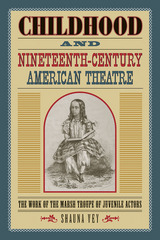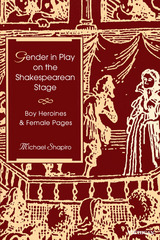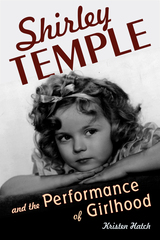3 books about Child actors

Childhood and Nineteenth-Century American Theatre
The Work of the Marsh Troupe of Juvenile Actors
Shauna Vey
Southern Illinois University Press, 2015
From 1855 until 1863, the Marsh Troupe of Juvenile Comedians, a professional acting company of approximately thirty children, entertained audiences with their nuanced performances of adult roles on stages around the globe. In Childhood and Nineteenth-Century American Theatre: The Work of the Marsh Troupe of Juvenile Actors, author Shauna Vey provides an insightful account not only of this unique antebellum stage troupe but also of contemporary theatre practices and the larger American culture, including shifts in the definition of childhood itself.
Looking at the daily work lives of five members of the Marsh Troupe—the father and manager, Robert Marsh, and four child performers, Mary Marsh, Alfred Stewart, Louise Arnot, and Georgie Marsh—Vey reveals the realities of the antebellum theatre and American society: the rise of the nineteenth-century impresario; the emerging societal constructions of girlhood and goodness; the realities of child labor; the decline of the apprenticeship model of actor training; shifts in gender roles and the status of working women; and changes in the economic models of theatre production, including the development of the stock company system.
Both a microhistory of a professional theatre company and its juvenile players in the decade before the Civil War and a larger narrative of cultural change in the United States, Childhood and Nineteenth-Century American Theatre sheds light on how childhood was idealized both on and off the stage, how the role of the child in society shifted in the nineteenth century, and the ways economic value and sentiment contributed to how children were viewed.
Looking at the daily work lives of five members of the Marsh Troupe—the father and manager, Robert Marsh, and four child performers, Mary Marsh, Alfred Stewart, Louise Arnot, and Georgie Marsh—Vey reveals the realities of the antebellum theatre and American society: the rise of the nineteenth-century impresario; the emerging societal constructions of girlhood and goodness; the realities of child labor; the decline of the apprenticeship model of actor training; shifts in gender roles and the status of working women; and changes in the economic models of theatre production, including the development of the stock company system.
Both a microhistory of a professional theatre company and its juvenile players in the decade before the Civil War and a larger narrative of cultural change in the United States, Childhood and Nineteenth-Century American Theatre sheds light on how childhood was idealized both on and off the stage, how the role of the child in society shifted in the nineteenth century, and the ways economic value and sentiment contributed to how children were viewed.
[more]

Gender in Play on the Shakespearean Stage
Boy Heroines and Female Pages
Michael Shapiro
University of Michigan Press, 1996
Cross-dressing, sexual identity, and the performance of gender are among the most hotly discussed topics in contemporary cultural studies. A vital addition to the growing body of literature, this book is the most in-depth and historically contextual study to date of Shakespeare's uses of the heroine in male disguise--man-playing-woman-playing-man--in all its theatrical and social complexity.
Shapiro's study centers on the five plays in which Shakespeare employed the figure of the "female page": The Two Gentlemen of Verona, The Merchant of Venice, As You Like It, Twelfth Night, and Cymbeline. Combining theater and social history, Shapiro locates Shakespeare's work in relation to controversies over gender roles and cross-dressing in Elizabethan England.
The popularity of the "female page" is examined as a playful literary and theatrical way of confronting, avoiding, or merely exploiting issues such as the place of women in a patriarchal culture and the representation of women on stage. Looking beyond and behind the stage for the cultural anxieties that found their way into Shakespearean drama, Shapiro considers such cases as cross-dressing women in London being punished as prostitutes and the alleged homoerotic practices of the apprentices who played female roles in adult companies. Shapiro also traces other Elizabethan dramatists' varied uses of the cross-dressing motif, especially as they were influenced by Shakespeare's innovations.
"Shapiro's engaging study is distinguished by the scope of interrelated topics it draws together and the balance of critical perspectives it brings to bear on them." --Choice
Michael Shapiro is Professor of English, University of Illinois, Urbana.
Shapiro's study centers on the five plays in which Shakespeare employed the figure of the "female page": The Two Gentlemen of Verona, The Merchant of Venice, As You Like It, Twelfth Night, and Cymbeline. Combining theater and social history, Shapiro locates Shakespeare's work in relation to controversies over gender roles and cross-dressing in Elizabethan England.
The popularity of the "female page" is examined as a playful literary and theatrical way of confronting, avoiding, or merely exploiting issues such as the place of women in a patriarchal culture and the representation of women on stage. Looking beyond and behind the stage for the cultural anxieties that found their way into Shakespearean drama, Shapiro considers such cases as cross-dressing women in London being punished as prostitutes and the alleged homoerotic practices of the apprentices who played female roles in adult companies. Shapiro also traces other Elizabethan dramatists' varied uses of the cross-dressing motif, especially as they were influenced by Shakespeare's innovations.
"Shapiro's engaging study is distinguished by the scope of interrelated topics it draws together and the balance of critical perspectives it brings to bear on them." --Choice
Michael Shapiro is Professor of English, University of Illinois, Urbana.
[more]

Shirley Temple and the Performance of Girlhood
Hatch, Kristen
Rutgers University Press, 2015
In the 1930s, Shirley Temple was heralded as “America’s sweetheart,” and she remains the icon of wholesome American girlhood, but Temple’s films strike many modern viewers as perverse. Shirley Temple and the Performance of Girlhood examines her early career in the context of the history of girlhood and considers how Temple’s star image emerged out of the Victorian cult of the child.
Beginning her career in “Baby Burlesks,” short films where she played vamps and harlots, her biggest hits were marketed as romances between Temple and her adult male costars. Kristen Hatch helps modern audiences make sense of the erotic undercurrents that seem to run through these movies. Placing Temple’s films in their historical context and reading them alongside earlier representations of girlhood in Victorian theater and silent film, Hatch shows how Shirley Temple emerged at the very moment that long standing beliefs about childhood innocence and sexuality were starting to change. Where we might now see a wholesome child in danger of adult corruption, earlier audiences saw Temple’s films as demonstrations of the purifying power of childhood innocence.
Hatch examines the cultural history of the time to view Temple’s performances in terms of sexuality, but in relation to changing views about gender, class, and race. Filled with new archival research, Shirley Temple and the Performance of Girlhood enables us to appreciate the “simpler times” of Temple’s stardom in all its thorny complexity.
[more]
READERS
Browse our collection.
PUBLISHERS
See BiblioVault's publisher services.
STUDENT SERVICES
Files for college accessibility offices.
UChicago Accessibility Resources
home | accessibility | search | about | contact us
BiblioVault ® 2001 - 2024
The University of Chicago Press









